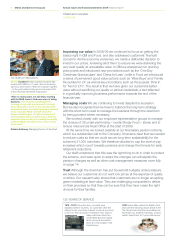Marks and Spencer 2009 Annual Report Download - page 20
Download and view the complete annual report
Please find page 20 of the 2009 Marks and Spencer annual report below. You can navigate through the pages in the report by either clicking on the pages listed below, or by using the keyword search tool below to find specific information within the annual report.
Balance sheet management
We took a number of actions to improve our cash flow in 2008/09.
In addition to reducing capital expenditure to £652m from over £1bn in the
previous year, we generated a working capital inflow of £194.0m and raised
£58.3m from the disposal of non-trading stores. As a result we generated
a net cash inflow of £107.5m after paying interest, tax, dividend and share
buy back of £661.2m. In addition we agreed certain changes to the
property partnership with the pension fund that provide us with discretion
around the annual payments from the partnership to the fund. This gives
us additional cash flow flexibility and reclassifies the obligation from debt
to equity.
As a result of our good cash flow management and the changes to
the property partnership, net debt at year-end was down to £2.5bn from
£3.1bn at the end of 2007/08.
Like many businesses, during 2008/09 we took steps to manage the
cost of providing our defined benefit pension scheme. We wanted to ensure
that pensions can be paid out to members when they need it and at a price
we can afford. From 1 October 2009 only pay increases up to 1% will count
towards the pensions of our existing members. Amendments were also
made to the early retirement factors for members who joined the scheme
before 1 January 1996 and are still active in the scheme. These changes
reduced the Group’s pension liabilities by £231.3m.
The retirement benefit valuation showed a deficit of £152.2m under IAS
19. The triennial actuarial valuation of the fund is underway with the results
expected by the end of the calendar year. This valuation will form the basis
of funding discussions with the pension trustee.
Looking forward, and with the economy still fragile, further strengthening
of our balance sheet is a priority for the Group. We want to retain our
investment grade credit rating, we want the ability to continue to invest
in our business, and we will need to continue to manage our pension
obligations.
In view of these requirements, the Board has taken the decision to re-base
the Group’s dividend payment to 15.0p per share from the current level of
22.5p per share, a reduction of 33.3%. This will be achieved through a 33.1%
reduction in the 2008/09 final dividend to 9.5p per share, followed by a
reduction in the 2009/10 interim dividend to 5.5p per share. Having re-based
the dividend to 15.0p per share, the Board’s policy regarding future dividends
is to re-build cover towards two times and thereafter, to grow dividends in
line with adjusted earnings per share.
Outlook
The economy remains uncertain and we will continue to manage
accordingly, focusing on margins, costs and cash flow so that we maximise
our profits in the short term, but also position our business to move forward
in the medium to longer term.
Ian Dyson Group Finance and Operations Director
16 Marks and Spencer Group plc Annual report and financial statements 2009 Directors’ report
Managing through the recession
by Ian Dyson, Group Finance
and Operations Director
125 YEARS OF SERVICE
1939 At the outbreak of World War II M&S
stores totalled 234. By 1945 over 100 of
these had been damaged by bombs and
16 had been completely destroyed.
During World War II 1,500 of M&S’ 2,000
male employees fought in the war earning a
total of 124 medals and distinctions and all of
our employees took part in fire watch duty
every night, with specialist training in first-aid
and anti-gas precautions.
Net debt
£2.5bn
























